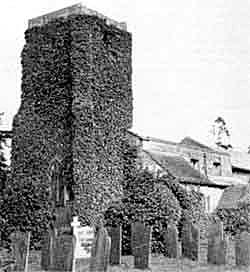< Previous | Contents | Next >
Edwalton church
 |
EDWALTON is situated in a backwater off the main line of traffic with the result that, in spite of its proximity to Nottingham and to West Bridgford, it still retains a good deal of its ancient, rural character .
It seems to derive its origin from a Saxon settler of the name of Eadweald, who reclaimed a parcel of waste in the midst of a boggy district. This boggy nature of the surroundings of Edwalton acted as a defence in times of difficulty, but it was also a nuisance, for it cut the settlement off from the nearest church which was at Tollerton .
Edwalton had no church until 1166, about which time Robert Fitz Ranulph founded Beauchief Abbey, and endowed it with, amongst other gifts, the living of Edwalton.
There was a lawsuit about Edwalton Church in 1228, which shows that it was then a chapelry to Flawford. But there is scant trace of whatever buildings stood on the site in those far-off days, and whatever is left has been altered and masked to such an extent as to be now almost unrecognisable.
The tower, covered by ivy planted about 1840, stands on an ancient stone foundation, and is built of red brick diapered in black. There is, however, a tradition, which seems likely to be right, that it was built during the reign of Queen Mary, and if that is so it must brick after the fashion used in Essex during the reign of Henry VII. be almost unique, for there was but little church building during her short but tumultuous reign. The original dedication of the church was to St. Lawrence and Holy Rood, but Holy Rood is used by itself nowadays .
It is a curious dedication of which there are only twenty-three examples in the country, and an erroneous tradition still exists that Edwalton Church was one of those built in expiation of the murder of St. Thomas a Becket.
Without being thrilling Edwalton Church is a delightful place, exhibiting to the full the " subtle beauty of age." Nor does it lack comedy, for in the churchyard will be found the tombstone of Rebecca Freeland, who died in 1741, with its curious, though not unique epitaph :
"She drank good ale, good punch, good wine,
And liv’d to th’
Age of Ninety-nine."
